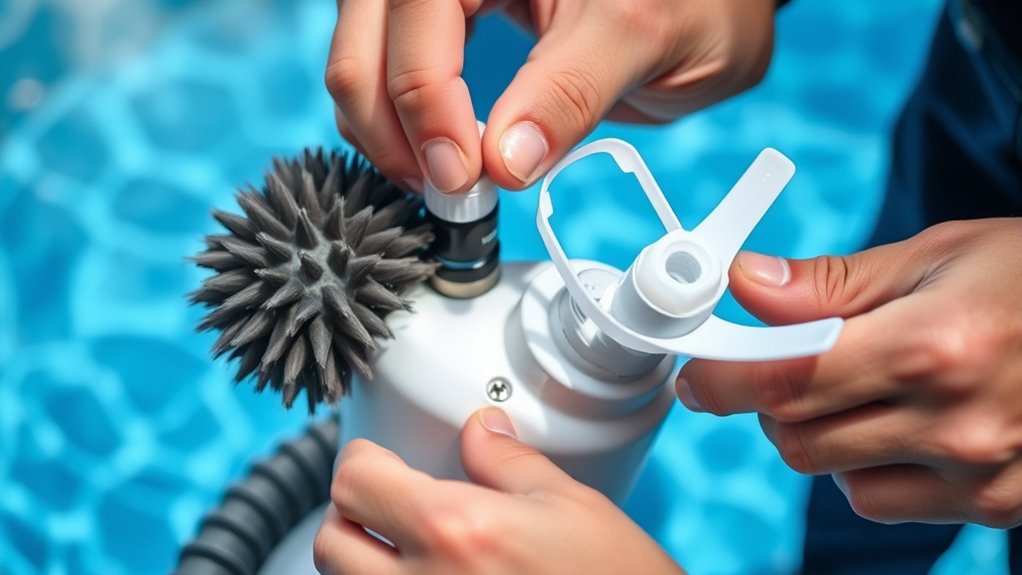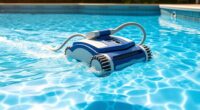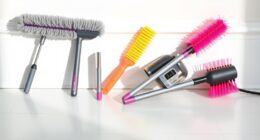To replace parts on your suction pool cleaner, start by inspecting for worn or damaged components like brushes, hoses, or filters. Remove old brushes carefully and securely attach new ones, making sure they move freely. Swap out hoses and connectors with compatible pieces, checking for secure fit and leaks. Clean or replace filters as needed, and follow the manufacturer’s instructions for proper installation. Keep up with regular maintenance, and you’ll keep your cleaner running smoothly—more tips await if you keep exploring.
Key Takeaways
- Identify worn or damaged components like brushes, hoses, or filters through visual inspection and performance issues.
- Remove old parts carefully, noting their orientation, and clean the surrounding areas before installing replacements.
- Select compatible replacement parts, including hoses and connectors, matching the cleaner’s model and pool setup.
- Regularly clean or replace filters to maintain optimal suction and prevent motor strain.
- Follow manufacturer instructions for proper installation and maintenance to ensure effective operation and longevity.
Identifying Worn or Damaged Components
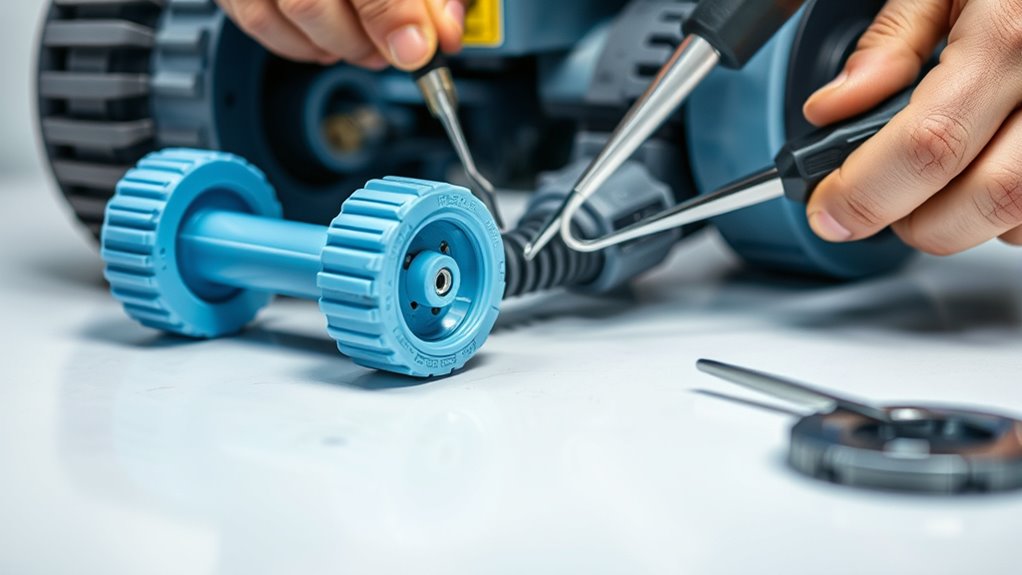
To keep your suction pool cleaner working efficiently, you need to recognize when parts are worn or damaged. Check for signs like reduced suction power, which indicates debris buildup or component wear. If your cleaner struggles to pick up pool debris or moves sluggishly, it’s a sign that parts such as hoses or filters may be compromised. Inspect the vacuum’s intake and hose connections for cracks, leaks, or blockages. Damaged or clogged parts decrease suction efficiency, making cleaning less effective. Also, listen for unusual noises or irregular movements, which can signal worn components. Regularly examining these areas helps you identify problems early, ensuring your cleaner continues to operate at peak performance and keeps your pool spotless. Additionally, understanding the different parts of a pool cleaner can assist you in pinpointing specific issues more precisely. Being familiar with the components of a suction pool cleaner can help you perform more targeted inspections and repairs.
Replacing the Brushes and Brooms
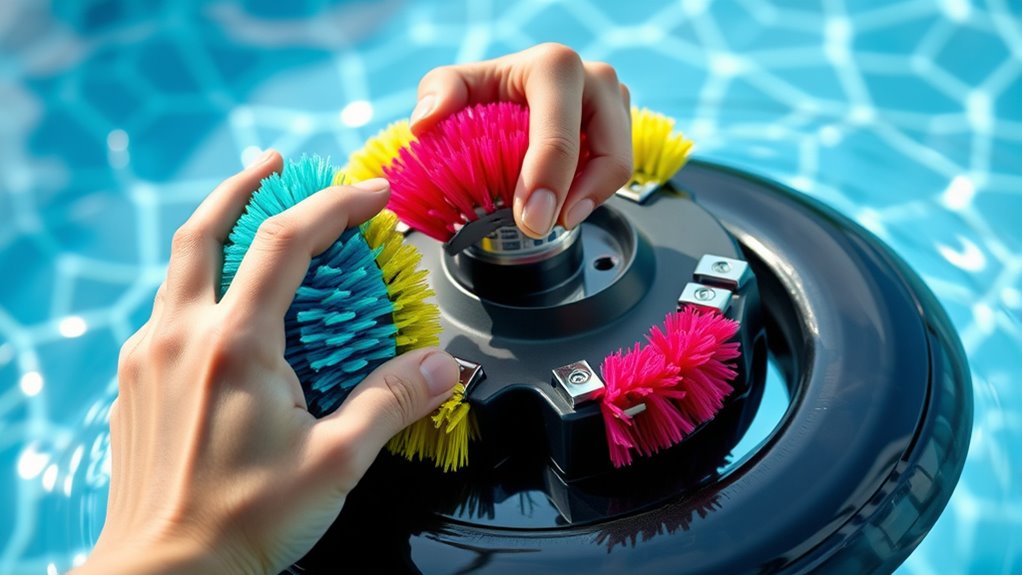
Have you noticed that your suction pool cleaner isn’t scrubbing the pool floor as effectively as it used to? It’s time for some brush replacement and broom maintenance. Worn brushes can reduce cleaning efficiency, so inspecting them regularly is key. When replacing brushes:
- Remove the old brushes carefully, noting their orientation.
- Clean the brush sockets and surrounding area to ensure proper fit.
- Attach the new brushes securely, making sure they move freely.
Keeping your brushes in good condition helps maintain ideal suction and cleaning power. Regular brush replacement prevents buildup of dirt and algae, ensuring your pool stays spotless. Proper maintenance of airless paint sprayers includes inspecting and replacing worn parts like brushes to keep the equipment functioning efficiently. Don’t forget to check for wear during routine maintenance to keep your cleaner working at its best.
Swapping Out the Hoses and Connectors

If your suction pool cleaner isn’t moving smoothly or isn’t maintaining strong suction, it might be time to swap out the hoses and connectors. First, check hose compatibility to verify the new hoses fit your cleaner’s model and pool setup. Different cleaners use varying hose diameters and materials, so selecting the right size is vital for peak performance. When replacing connectors, identify the connector types—some are quick-release, while others require clamps or screw fittings. Properly attaching the new hoses and connectors guarantees a secure seal, preventing leaks and loss of suction. Always verify that the connections are tight and compatible before testing the cleaner. A correct fit guarantees smooth operation and extends the lifespan of your pool cleaner.
Cleaning and Replacing the Filters

Regularly cleaning or replacing the filters on your suction pool cleaner guarantees it operates efficiently and maintains strong suction. Start with filter inspection to identify dirt buildup or damage. When needed, follow these steps:
- Remove the filter from the cleaner and rinse it thoroughly with water.
- Check for tears or clogs that could hinder performance.
- Replace the filter if cleaning doesn’t restore proper function.
- Using keto-friendly ingredients for maintenance can help reduce residue buildup and keep your filters cleaner longer. Incorporating proper maintenance practices can further extend the lifespan of your filters and ensure optimal performance. Additionally, understanding emergency preparedness essentials can help you develop a comprehensive approach to maintaining your pool equipment during unexpected events. Staying informed about pool safety guidelines is crucial to prevent accidents and ensure safe operation of your equipment. Regular filter maintenance also contributes to energy efficiency, reducing overall power consumption and operational costs. Keeping filters clean supports motor maintenance by preventing debris from overworking the motor. Regular filter checks ensure ideal suction and prolong the lifespan of your cleaner. Remember, a clean filter means less strain on the motor, reducing repair needs and improving overall efficiency. Proper filter care is essential for maintaining peak performance of your suction pool cleaner.
Tips for Proper Installation and Maintenance

Proper installation and maintenance are crucial for ensuring your suction pool cleaner performs at its best and lasts longer. Start by confirming chemical compatibility with your pool chemicals to prevent damage to parts and maintain efficiency. Always follow the manufacturer’s instructions closely during installation, ensuring all connections are secure and aligned correctly. Regularly inspect your cleaner for wear and tear, cleaning parts as needed to avoid clogs and malfunctions. Keep warranty considerations in mind; using non-approved parts or improper installation can void your warranty, so stick to recommended replacements. Proper maintenance not only extends the lifespan of your cleaner but also guarantees peak cleaning performance. By paying attention to chemical compatibility and adhering to warranty guidelines, you’ll keep your pool cleaner running smoothly season after season.
Frequently Asked Questions
How Often Should I Replace Suction Pool Cleaner Parts?
You should regularly inspect your suction pool cleaner parts to maintain effective pool maintenance and guarantee equipment longevity. Typically, replace brushes, hoses, and skirts every 6 to 12 months or when you notice signs of wear. Check the manufacturer’s guidelines for specific recommendations. Doing routine replacements helps prevent breakdowns, keeps your cleaner working efficiently, and extends its lifespan, ultimately saving you time and money on costly repairs.
Can I Use Generic Parts Instead of Manufacturer Replacements?
Think of your pool cleaner as a finely-tuned orchestra; each part must play in harmony. Using generic parts might seem like a shortcut, but compatibility concerns can turn your symphony into a discord. While they may save money upfront, they often don’t fit perfectly, risking damage or reduced efficiency. It’s best to stick with manufacturer replacements to guarantee your cleaner performs flawlessly, keeping your pool pristine and trouble-free.
Are There Specific Tools Required for Part Replacement?
When replacing parts on your suction pool cleaner, you might wonder about the tools needed. Typically, you’ll need basic tools like screwdrivers and pliers, but specific tools depend on the part you’re replacing. Compatibility considerations are essential—ensure your tools match the fasteners and components of your cleaner. Using the right tools helps prevent damage and makes the replacement smoother. Always consult your manufacturer’s instructions for precise tools and compatibility info.
How Do I Troubleshoot if the Cleaner Still Malfunctions After Replacement?
If your cleaner still malfunctions after replacement, start troubleshooting by checking the filter maintenance. A clogged filter can hinder performance. Then, inspect the hose for cracks or blockages that might restrict water flow. Make sure all connections are secure. Regularly cleaning the filter and inspecting the hose assure your suction pool cleaner operates efficiently. If issues persist, consider further parts inspection or consulting a professional.
Is Professional Servicing Recommended for Complex Repairs?
If you’re facing complex repairs on your suction pool cleaner, professional servicing is recommended. It guarantees DIY safety and prevents potential damage that could impact your warranty. While some repairs are straightforward, complex issues often require specialized tools and expertise. By choosing a professional, you minimize risks, ensure proper fix, and maintain your warranty coverage. Don’t risk DIY mishaps that could lead to costly future repairs or voiding your warranty.
Conclusion
By regularly inspecting and replacing worn parts on your suction pool cleaner, you guarantee it stays efficient and lasts longer. Think of it like maintaining a well-oiled machine—you keep it running smoothly by addressing issues early. Some believe that a cleaner’s performance can directly influence water clarity, which science supports through improved filtration. So, take proactive steps; your pool will thank you with sparkling, inviting water all season long.

